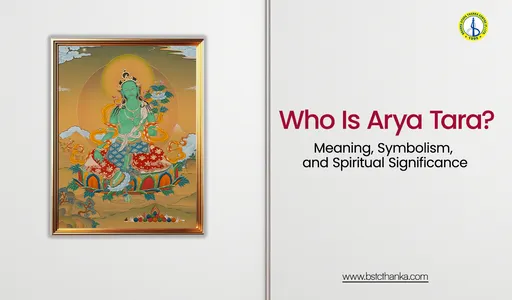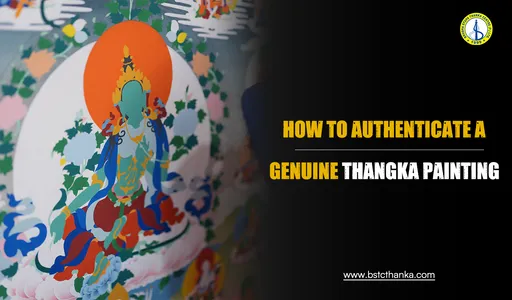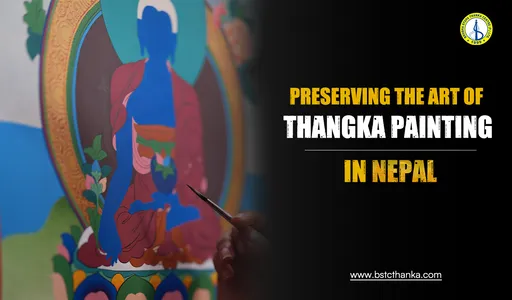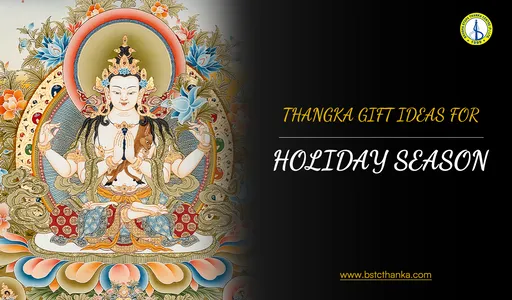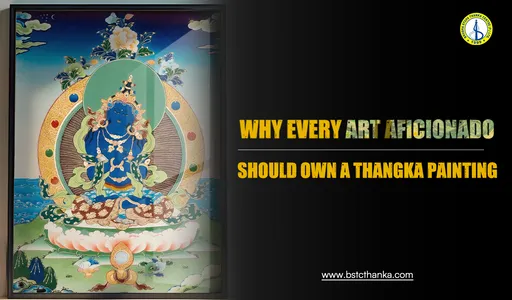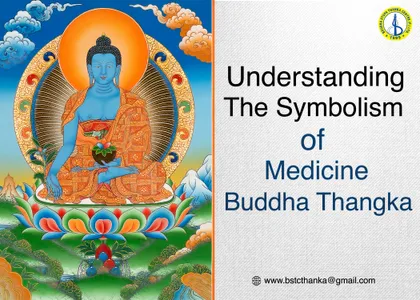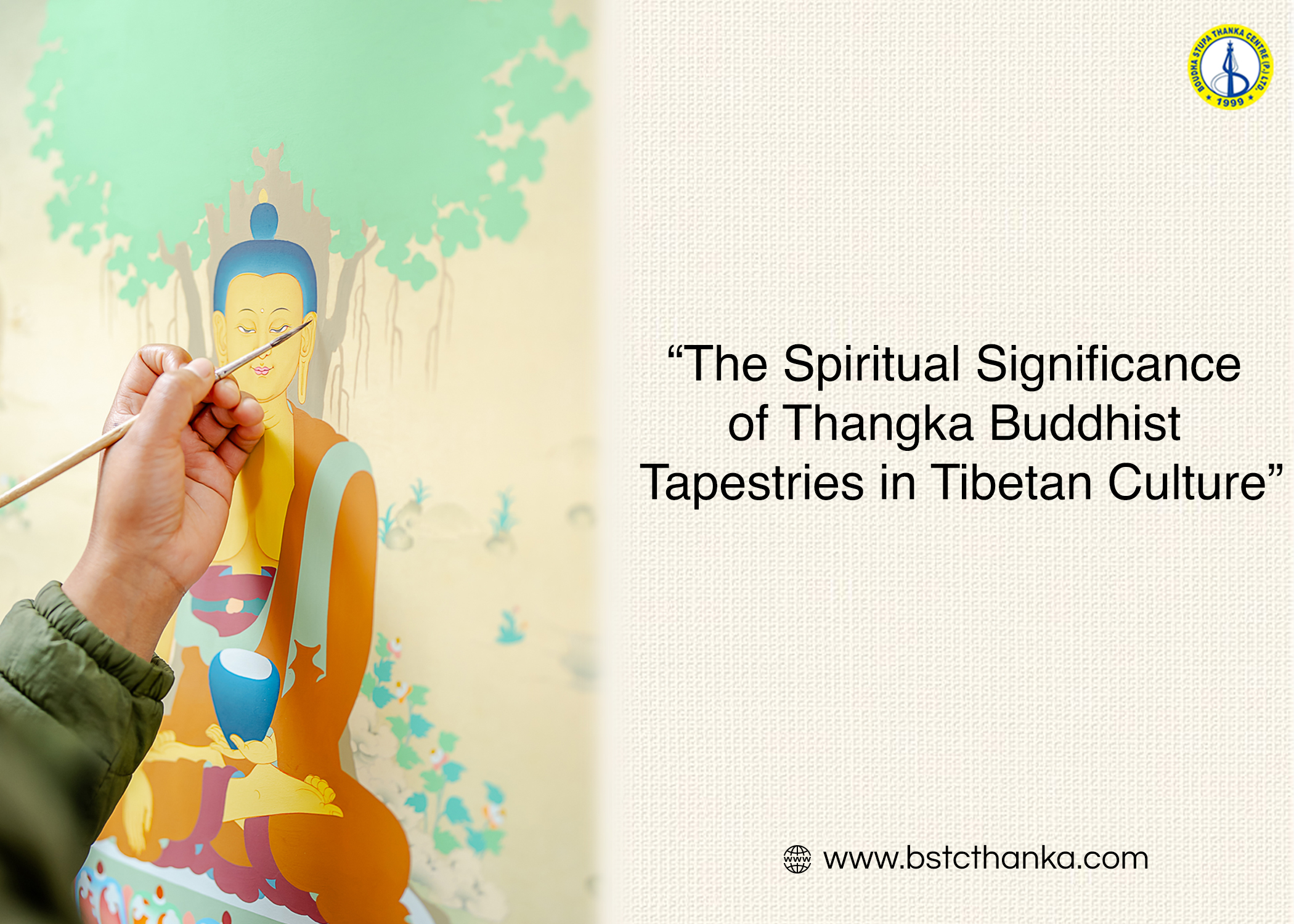
The Spiritual Significance of Thangka Buddhist Tapestries in Tibetan Culture
Thangkas are traditional Buddhist scroll paintings or tapestries originating from Tibet and India. These sacred artworks are painted or embroidered on cotton or silk and often framed in colorful brocade fabric. Thangkas depict a wide range of subjects, including deities, mandalas, religious figures, teachings, and symbolic scenes from Buddhist cosmology.
Thangka painting originated in Tibet around the 7th century, influenced by Indian, Nepalese, and Chinese artistic traditions. These sacred scroll paintings depict Buddhist deities, mandalas, and religious narratives, serving as meditation aids and teaching tools. Traditionally crafted using mineral pigments on cotton or silk, thangkas are highly detailed and often consecrated by monks. The art flourished under the patronage of Tibetan monasteries and later spread to Nepal and Bhutan. Over time, different styles developed, including Menri, Karma Gadri, and Newar styles. Today, thangka painting remains a revered spiritual practice, preserving Buddhist teachings and artistic heritage across the Himalayas.
Typically rectangular, thangkas are designed to be portable, making them suitable for both personal meditation and public rituals. They are hung in temples, monasteries, or homes and are used as aids for visualization, meditation, and teaching. The vivid colors, intricate details, and symbolic imagery make thangkas a remarkable fusion of art and spirituality.
Cultural and Spiritual Relevance in Tibetan Buddhism
1. Tools for Meditation and Visualization
Thangkas are vital tools in Tibetan Buddhism for meditation practices. Practitioners focus on detailed imagery to internalize the attributes of a deity or mandala, enhancing their understanding of profound teachings and progressing along their spiritual path. For instance, a thangka of Avalokiteshvara, the bodhisattva of compassion, helps meditators cultivate compassion and empathy.
2. Preservation of Buddhist Teachings
Thangkas serve as visual representations of Buddhist philosophy and cosmology, encapsulating complex teachings in an accessible format. Each element in a thangka, be it a deity’s hand gesture (mudra), a lotus flower, or the colors used, holds a specific symbolic meaning that conveys essential aspects of Buddhist thought. This tradition has helped preserve Buddhist teachings for centuries, especially in communities with oral traditions.
3. Ritual and Ceremonial Use
Thangkas are central to Tibetan Buddhist ceremonies, where they are displayed or unveiled during festivals and rituals. A giant thangka, for instance, may be unrolled during special occasions like the Tibetan New Year (Losar) to bless devotees. They are also used in death rituals, helping guide the deceased through the bardo (intermediate state) toward enlightenment.
4. Cultural Identity and Heritage
In Tibetan culture, thangkas represent a rich artistic tradition that integrates religion, philosophy, and history. Creating a thangka is a spiritual practice in itself, requiring months or even years of meticulous work by skilled artisans. Each artist adheres to strict iconographic guidelines, ensuring the thangka’s authenticity and spiritual efficacy.
5. Spiritual Merit and Blessings
Owning or commissioning a thangka is believed to generate spiritual merit and blessings. Devotees hang thangkas in their homes or monasteries as a form of devotion and to invoke the protective and enlightening qualities of the deities depicted.
Symbolism in Thangka Tapestries
Thangka tapestries are deeply symbolic works of art, with each detail meticulously crafted to convey profound spiritual teachings. The imagery, colors, and geometric patterns are not merely decorative but represent Buddhist philosophy, cosmology, and the path to enlightenment. Understanding the symbolism within these sacred tapestries reveals their significance as tools for meditation, spiritual guidance, and preservation of Buddhist teachings. Artists cannot create these works solely from their own imagination; they must adhere to established rules and guidelines to ensure each thangka is a faithful representation of Buddhist traditions.
Common Themes in Thangka Tapestries
-
Mandalas
Symbolic Meaning: Mandalas serve as maps of the cosmos and meditative tools to guide practitioners toward spiritual awakening. The symmetrical patterns reflect the interconnectedness of all existence.
Mandalas are intricate geometric designs that represent the universe and the spiritual journey. At their center lies a deity or sacred symbol, symbolizing the ultimate goal of enlightenment. Surrounding elements often depict the practitioner's path, including purification, realization, and union with the divine.-
Usage: Practitioners meditate on mandalas to focus their minds, gain insight, and connect with cosmic energies.
-
-
Deities
Thangkas frequently depict Buddhist deities, bodhisattvas, or protectors, each embodying specific virtues or teachings. For example:-
Avalokiteshvara : Represents compassion, often depicted with multiple arms symbolizing the ability to help countless beings.
-
Green Tara: Symbolizes swift action and liberation from suffering.
-
Wrathful Deities: Such as Mahakala or Vajrapani, embody the fierce protection of Dharma and the destruction of ignorance.
-
Symbolic Meaning: Deities in thangkas are not worshipped as external gods but are seen as manifestations of enlightened qualities inherent within every being.
-
-
Scenes from Buddha’s Life
Thangkas often narrate pivotal moments in the life of Siddhartha Gautama, the historical Buddha, such as:-
His birth symbolizes purity and the potential for enlightenment.
-
His meditation under the Bodhi tree represents the triumph over ignorance.
-
His first sermon depicts the transmission of the Dharma.
-
These scenes inspire practitioners by illustrating the Buddha’s journey and teachings as a model for their own spiritual path.
Spiritual Meanings Behind Intricate Designs
-
Colors
Each color in a thangka has a specific spiritual significance:-
White: Purity and wisdom.
-
Red: Compassion and transformation of desire.
-
Blue: Infinity and the vast nature of the mind.
-
Green: Active compassion and balance.
-
Yellow: Abundance and generosity.
The harmonious use of these colors creates an environment conducive to meditation and spiritual focus. -
Gold: 24-karat gold used in Thangka emphasizes divine purity.
-
-
Sacred Geometry
The symmetry and proportions in thangkas are guided by precise iconographic rules. They reflect cosmic harmony and the balance between the physical and spiritual realms. The central figure, often larger and more detailed, signifies its importance while surrounding elements represent supporting energies or teachings. -
Lotus Flowers
The lotus flower is a recurring motif symbolizing purity and spiritual awakening. Rooted in mud yet blooming beautifully, it represents the potential for enlightenment despite worldly challenges. -
Mudras (Hand Gestures)
The hand gestures of deities and Buddhas carry specific meanings:-
Abhaya Mudra: Fearlessness and protection.
-
Dharmachakra Mudra: Turning the wheel of Dharma, symbolizing teaching.
-
Varada Mudra: Generosity and granting blessings.
-
-
Animals and Symbols
Many thangkas feature animals or sacred symbols, each with deep spiritual connotations:-
Snow Lions: Courage and joy.
-
Peacocks: Transformation of poison into wisdom.
-
Vajra (Thunderbolt): The indestructible nature of truth.
-
How Thangka Tapestries Are Used in Tibetan Buddhism
Thangka tapestries play a pivotal role in Tibetan Buddhism, serving as more than mere decorative art. They are sacred tools that facilitate spiritual practice, education, and ceremonial rituals. These intricately crafted scrolls bridge the physical and metaphysical worlds, helping practitioners deepen their understanding of Buddhist teachings and their connection to the divine.
1. Meditation Aids
Thangkas are powerful aids for meditation, guiding practitioners toward focused concentration and spiritual growth.
-
Visualization Practice:
Practitioners often focus on a specific deity or mandala depicted in a thangka to internalize its qualities. For example, meditating on Avalokiteshvara (the bodhisattva of compassion) helps cultivate compassion, while focusing on a wrathful deity like Mahakala assists in overcoming obstacles. -
Symbolic Guidance:
The intricate details of a thangka serve as a visual map, guiding the meditator through complex spiritual concepts. Mandalas, in particular, represent the cosmic order and the path to enlightenment, helping practitioners visualize the process of transcending worldly illusions. -
Personal Connection:
Many practitioners keep personal thangkas as focal points for their daily meditation, enabling them to establish a sacred space in their homes.
2. Teaching Tools
Thangkas encapsulate Buddhist philosophy and teachings, making them invaluable tools for both laypeople and monastics.
-
Illustrating Buddhist Cosmology:
Thangkas depicting the "Wheel of Life" (Bhavachakra) explain the cyclical nature of samsara (birth, death, and rebirth) and the path to liberation. Teachers use such thangkas to simplify complex ideas for students. -
Depicting Deities and Lineages:
Tapestries showcasing lineages of Tibetan Buddhist masters or specific deities help practitioners trace the historical and spiritual origins of their teachings. This fosters a deeper appreciation of their faith and tradition. -
Portable Lessons:
Historically, the portability of thangkas made them ideal teaching tools for traveling monks, who carried them to villages and remote regions to spread Buddhist teachings.
3. Ceremonial Backdrops
Thangkas play a central role in Buddhist rituals and ceremonies, symbolizing divine presence and serving as conduits for blessings.
-
Ritual Displays:
Large thangkas, known as "tromas" or "giant appliqué thangkas," are displayed during important festivals, such as Losar (Tibetan New Year) or monastery anniversaries. These magnificent shows draw devotees who come to seek blessings and offer prayers. -
Invoking Deities:
During pujas (rituals), thangkas depicting specific deities are placed on altars or hung in sacred spaces to invite the deity's presence. Practitioners chant mantras and perform offerings in front of the thangka, aligning their intentions with the depicted deity's qualities. -
Death and Transition Rituals:
Thangkas are often used during funeral ceremonies to guide the deceased through the bardo (intermediate state) and aid their rebirth or liberation. Deities like Amitabha, who symbolizes the pure land, are commonly depicted to ensure safe passage for the soul.
Stories of Thangka Usage in Buddhist Monasteries
1. The Unveiling of the Giant Thangka at Tashilhunpo Monastery
At Tashilhunpo Monastery in Tibet, a massive thangka is unveiled once a year during the Sho Dun Festival. This breathtaking tapestry, spanning several stories high, depicts a Buddha or bodhisattva and serves as a focal point for collective prayers and blessings. Devotees believe that witnessing this thangka purifies negative karma and brings spiritual merit.
2. Thangkas in Monastic Education
In monasteries, monks-in-training use thangkas to learn Buddhist cosmology and iconography. For instance, thangkas of the "Six Realms of Existence" help monks understand the karmic cycles of rebirth and the paths leading to enlightenment. Senior monks explain these teachings with reference to the detailed imagery on the tapestries.
3. Thangka as a Central Altar Piece
In many monasteries, a thangka depicting the monastery’s patron deity or founder is displayed prominently in the main prayer hall. This thangka becomes a centerpiece for daily prayers and rituals, embodying the spiritual essence of the institution.
The Multifaceted Role of Thangkas
Thangka tapestries are versatile and profound, serving multiple functions within Tibetan Buddhism:
- As meditation tools, they deepen spiritual practice.
- As teaching aids, they preserve and transmit Buddhist philosophy.
- As ritual objects, they connect practitioners to the divine.
The Making of a Thangka Buddhist Tapestry
Every thangka is an intricate work of art, painstakingly crafted by skilled artisans who honor traditional techniques that have been passed down through countless generations. These artists employ natural mineral pigments sourced from various elements found in nature, along with luxurious gold leaf, to create stunningly vibrant colors that endure over time. The meticulous process of painting each detail is not merely an act of creation; it is regarded as a meditative practice. During the creation of a thangka, artists often recite prayers and mantras, infusing the artwork with spiritual energy and intention. Each brushstroke serves not only to depict sacred imagery but also to connect the artist with centuries of cultural and spiritual heritage, making each thangka a profound expression of devotion and craftsmanship.
Supporting the Preservation of Tibetan Culture
Investing in authentic thangka art not only supports local artisans but also plays a crucial role in the preservation of Tibetan cultural heritage. Thangka paintings, which are intricate and often depict religious themes and figures, have been an essential part of Tibetan Buddhism for centuries. By acquiring a thangka, you are not merely purchasing a piece of art; you are becoming a guardian of this sacred tradition. Your investment helps sustain the skilled craftsmen and women who dedicate their lives to this meticulous process, ensuring that the techniques and narratives behind thangka creation are passed down through generations. In doing so, you contribute to the continuing journey of this remarkable art form, allowing future generations to experience and appreciate its beauty and significance.
Conclusion
Thangka Buddhist tapestries represent much more than mere decorative art; they serve as significant spiritual tools, cultural artifacts, and deep manifestations of Buddhist philosophy. These intricate paintings, often depicting deities, mandalas, or important scenes from the life of the Buddha, are traditionally created by skilled artisans who follow centuries-old techniques. Each thangka is meticulously handcrafted, capturing not only the vibrant colors and intricate details but also the essence of Tibetan spirituality and tradition.
By exploring the curated collection of handcrafted thangkas at BSTC, you have the opportunity to invite a piece of this rich heritage into your life. Whether for personal contemplation, meditation, or simply as an inspiring addition to your home decor, a thangka is a unique way to connect with Buddhist wisdom and culture. Embrace the chance to enrich your surroundings with these profound works of art that carry deep meaning and history.




